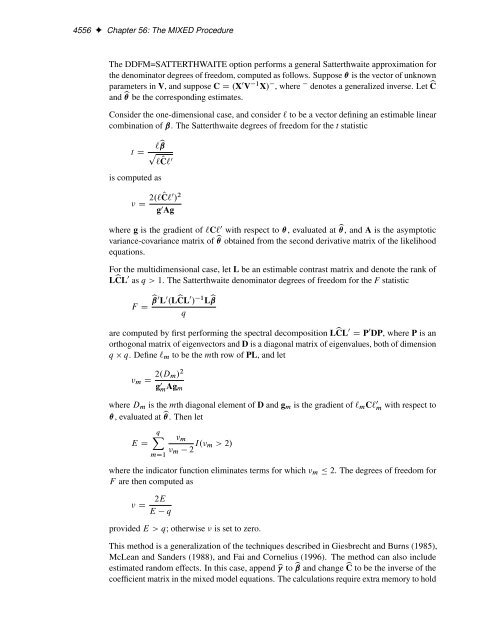SAS/STAT 922 User's Guide: The MIXED Procedure (Book Excerpt)
SAS/STAT 922 User's Guide: The MIXED Procedure (Book Excerpt)
SAS/STAT 922 User's Guide: The MIXED Procedure (Book Excerpt)
You also want an ePaper? Increase the reach of your titles
YUMPU automatically turns print PDFs into web optimized ePapers that Google loves.
4556 ✦ Chapter 56: <strong>The</strong> <strong>MIXED</strong> <strong>Procedure</strong><br />
<strong>The</strong> DDFM=SATTERTHWAITE option performs a general Satterthwaite approximation for<br />
the denominator degrees of freedom, computed as follows. Suppose is the vector of unknown<br />
parameters in V, and suppose C D .X 0 V 1 X/ , where denotes a generalized inverse. Let bC<br />
and b be the corresponding estimates.<br />
Consider the one-dimensional case, and consider ` to be a vector defining an estimable linear<br />
combination of ˇ. <strong>The</strong> Satterthwaite degrees of freedom for the t statistic<br />
t D `bˇ<br />
p<br />
` OC` 0<br />
is computed as<br />
D 2.` OC` 0 / 2<br />
g 0 Ag<br />
where g is the gradient of `C` 0 with respect to , evaluated at b, and A is the asymptotic<br />
variance-covariance matrix of b obtained from the second derivative matrix of the likelihood<br />
equations.<br />
For the multidimensional case, let L be an estimable contrast matrix and denote the rank of<br />
LbCL 0 as q > 1. <strong>The</strong> Satterthwaite denominator degrees of freedom for the F statistic<br />
F D bˇ 0 L 0 .LbCL 0 / 1 Lbˇ<br />
q<br />
are computed by first performing the spectral decomposition LbCL 0 D P 0 DP, where P is an<br />
orthogonal matrix of eigenvectors and D is a diagonal matrix of eigenvalues, both of dimension<br />
q q. Define `m to be the mth row of PL, and let<br />
m D<br />
2.Dm/ 2<br />
g 0 m Agm<br />
where Dm is the mth diagonal element of D and gm is the gradient of `mC` 0 m<br />
, evaluated at b. <strong>The</strong>n let<br />
E D<br />
qX<br />
mD1<br />
m<br />
m<br />
2 I. m > 2/<br />
where the indicator function eliminates terms for which m<br />
F are then computed as<br />
D 2E<br />
E q<br />
provided E > q; otherwise is set to zero.<br />
with respect to<br />
2. <strong>The</strong> degrees of freedom for<br />
This method is a generalization of the techniques described in Giesbrecht and Burns (1985),<br />
McLean and Sanders (1988), and Fai and Cornelius (1996). <strong>The</strong> method can also include<br />
estimated random effects. In this case, append b to bˇ and change bC to be the inverse of the<br />
coefficient matrix in the mixed model equations. <strong>The</strong> calculations require extra memory to hold

















